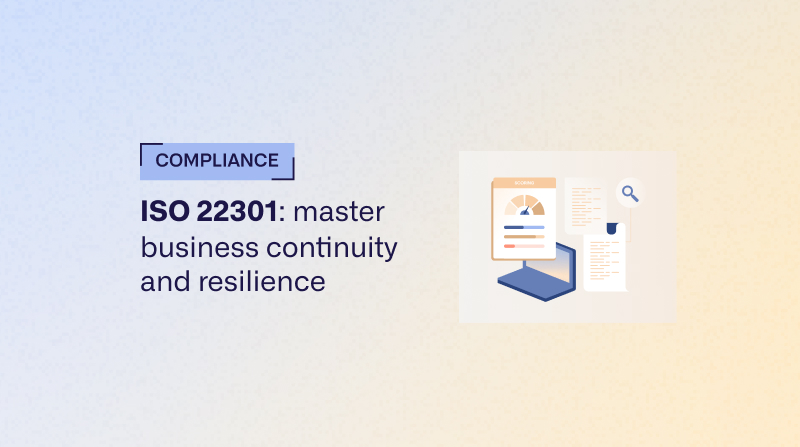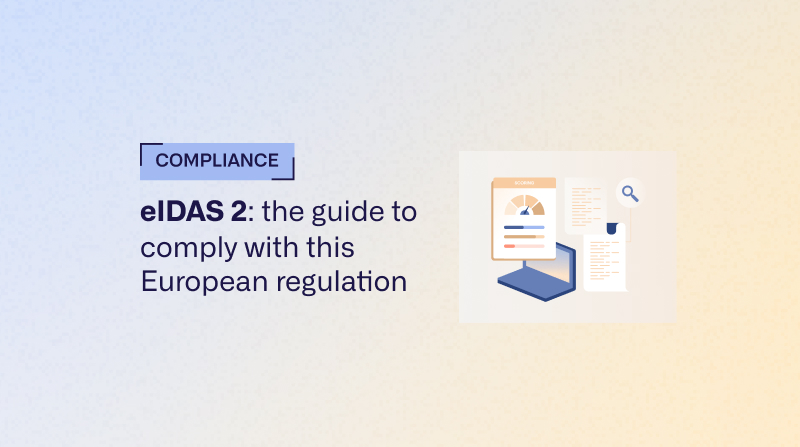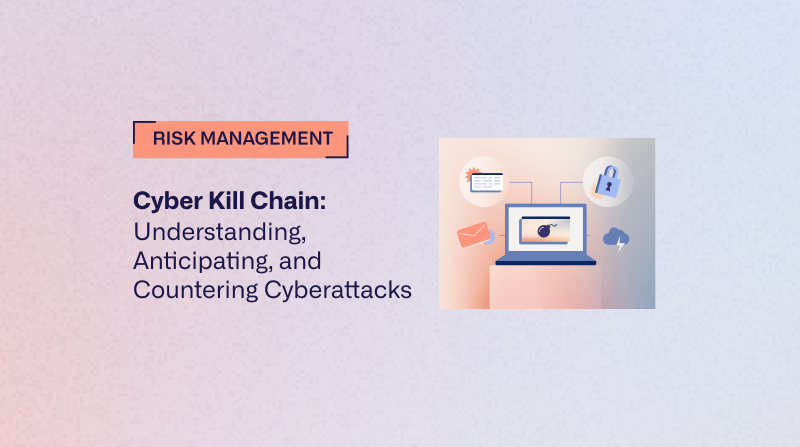ISO 22301: the key standard for managing business continuity
In 2025, business continuity is no longer an option: cyberattacks, health crises or technical incidents remind us of the importance of a structured approach. The ISO 22301 standard helps businesses to prevent the interruption of their critical activities and to prove their resilience.
What is the ISO 22301 standard?
The ISO 22301 standard is the international reference standard for business continuity management (or Business Continuity Management Systems). It provides a framework for organizations to prepare for, respond to, and recover from disruptive incidents. For a company, the adoption of the ISO 22301 standard is not just a simple compliance process, it is a pillar of resilience and Cyber Security GRC.
Whether you are RSSI, Risk Manager, or CIO, understanding the requirements of this standard is essential for building an effective business continuity management system (BMS). Properly implemented, this system helps to reduce the impact of crises, protect critical assets, maintain the trust of stakeholders and ensure the survival of the organization in the face of the unexpected.
The objectives and challenges of the ISO 22301 standard
ISO 22301, entitled “Security and Resilience — Business Continuity Management Systems — Requirements”, is the international standard that specifies requirements for planning, establishing, implementing, operating, monitoring, monitoring, monitoring, reviewing, reviewing, maintaining, and continuously improving a documented management system. This system aims to protect the organization from, reduce the likelihood of, and prepare for, respond to, and recover from disruptions when they occur.
In other words, it offers a structured method to ensure that your business can continue. even in the event of a major incident (computer failure, natural disaster, cyber attack, pandemic, etc.). It is a guide to building organizational resilience.
The implementation of an SMCA: foundations of the ISO 22301 standard
The fundamental objective of the ISO 22301 standard is to implement a business continuity management system (SMCA) effective. It is a global management process that integrates business continuity into company culture and processes. It aims to ensure that the organization can deliver its products and services at predefined levels that are acceptable following a disruption. To achieve this, the standard is based on the PDCA cycle (Plan, Deploy, Control, Act), a continuous improvement model that ensures that the SMCA remains relevant and effective over time.
Why adopt the ISO 22301 standard in your business?
In a world where threats are increasingly complex and interconnected, the inability to maintain critical activities can have disastrous consequences: financial losses, reputational damage, loss of customers, regulatory sanctions. The ISO 22301 standard helps your organization to:
- Identify and understand threats to your business
- Minimize the impact of a mishap thanks to plans proven response and recovery.
- Respect the requisites legal, regulatory and contractual.
- Gain a competitive advantage by demonstrating your resilience.
The key requirements of the ISO 22301 standard for an effective SMCA
The implementation of a SMCA in accordance with the standard ISO 22301 is based on a series of requirements structured in chapters. Understanding these requirements is the first step to successful implementation. Let's take a look at the main clauses that make up this iso standard.
Context of the organization (clause 4)
Above all, the organization must understand itself. This step requires clearly defining the scope of application of the SMCA, identifying internal and external stakeholders (employees, customers, suppliers, regulators) and understanding their expectations. This is where it is determined which processes and services are critical and should be included within the scope of the management system. A good risk analysis starts with a precise definition of this perimeter.
Leadership and commitment (clause 5)
No project of this scale can succeed without strong support from management. The standard requires management to demonstrate commitment by defining a business continuity policy, allocating the necessary resources (human, financial, technical), and clearly defining roles and responsibilities. Leadership is the driver that ensures that business continuity is not a one-off project, but an integral part of corporate governance.
SMCA planning (clause 6)
This clause is at the heart of the approach. The organization must identify the risks and opportunities associated with its SMCA. This involves conducting a Business Impact Assessment (BIA - Business Impact Analysis) and a valuation Of risks.
- Business impact analysis (BIA) makes it possible to identify critical activities and the resources on which they depend. This process helps determine the maximum tolerable recovery times (RTO - Recovery Time Objective) and the maximum allowable data losses (RPO - Recovery Point Objective).
- THEvaluation Of risks : it is about identifying, analyzing and evaluating the risks of disruption that could affect critical activities. This includes technical threats (cyberattacks, hardware failures) as well as non-technical threats (strikes, pandemics, supply chain disruptions).
Based on this planning, clear and measurable business continuity goals should be established.
Modeling these dependencies and risk scenarios can become very complex. A platform like Egerie allows you to map your critical assets and processes, simulate the impact of disruptions, and objectively prioritize your efforts.
To find out how, request a demo of our solution.
Support and resources (clause 7)
For the SMCA to work, it must be given the means to achieve its ambitions. This section covers the provision of resources, the definition of required competencies, staff awareness, and communication. The organization should ensure that the people involved in the business continuity plan have the required knowledge and skills Clear and accessible documentation is also a fundamental requirement, describing the SMCA, policies, processes, and plans.
How to deploy an ISO 22301 business continuity plan
The implementation of the ISO 22301 standard is a structured project that follows a clear logic. The success of the process depends on careful planning and the involvement of all parties concerned.
Establishing business continuity strategies and solutions
Once the impact analysis and risk assessment are complete, the organization must define strategies to ensure continuity. These strategies should aim to protect priority activities, stabilize the situation after an incident, and allow for a timely recovery.
The solutions can be very varied:
- Technical solutions such as backup sites, redundant backups, high availability solutions, or protocol protection such as IPsec for remote access.
- Organizational solutions such as the identification of alternative suppliers, the training of crisis teams and the implementation of teleworking.
- Human solutions, namely the versatility of skills, succession plans for key roles.
The choice of strategies must be an arbitration between the accepted level of risk, the cost of the solution and the recovery time targeted.
Develop and implement business continuity plans (BCAs)
The strategies are then translated into concrete action plans. These plans should be clear, concise and directly usable in crisis situations. A good business continuity plan (BCP) should contain:
- Les activation procedures of the plan.
- Les roles and responsibilities From the team of crisis management.
- Les proceedings internal and external communication.
- Les technical and manual steps for the resumption of each critical activity.
- Les key contacts (suppliers, emergency services, etc.).
These plans should not be static documents: they should live and be known to all of your teams.
Test and exercise plans
A plan that has never been tested is likely to fail. The ISO 22301 standard requires that the organization exercises and tests its business continuity procedures regularlyé. These tests make it possible to:
- Validate the effectiveness of strategies and plans.
- Train teams and make sure they know their role
- Identify gaps, errors, or areas for improvement.
- Verify that the defined RTOs and RPOs are achievable.
Exercises can take several forms, from a simple review of a plan in the room to the complete simulation of a disaster. Each test must be reported and lead to a corrective action plan.
The management of these tests, results, and improvement plans can be centralized within a GRC platform. Egerie makes it easy to track your exercises and integrate the results into your continuous improvement cycle.
Want to know more? Ask for a demo with our team of experts now.
Audit and continuous improvement: the heart of the ISO 22301 cycle
An SMCA is not a project with an end, but a permanent cycle of improvement. Clauses 9 and 10 of the ISO 22301 standard are dedicated to this dynamic.
Monitoring, measurement and evaluation (clause 9)
The organization must define what it will monitor to assess the performance of its SMCA. This can include performance indicators (KPIs) such as test recovery time, backup recovery success rate, or team training level.
THEcompliance audit internal is a key requirement. Carried out at planned intervals, it makes it possible to verify that the SMCA complies with the requirements of the ISO 22301 standard and with the company's own policies.
Finally, management must conduct a regular review of the SMCA (the management review) to ensure its relevance, adequacy and effectiveness. It is during this review that strategic decisions concerning the evolution of the system are made.
Continuous improvement (clause 10)
When non-compliance is detected (following an audit, test, or actual incident), the organization must respond. She must analyze the cause of the problem and put in place corrective actions to prevent it from happening again.
This logic of continuous improvement is the driver of resilience. An effective SMCA is a system that continuously learns and adapts to new threats, changes in the organization, and lessons learned from past incidents. This proactive approach is fundamental, whether in order to meet sectoral regulations such as DORA in finance or Part-is in aeronautics.
The governance of this improvement cycle is simplified by tools that centralize non-conformities, action plans and monitoring their implementation.
Governance, risks and compliance with ISO 22301
For a CISO or a Risk Manager, the ISO 22301 standard is more than a framework: it is a governance tool. It makes it possible to integrate business continuity into a global approach to management of risks associated with third parties and compliance. The adoption of ISO 22301 fits perfectly into larger frameworks such as NIST framework, which includes Respond & Recover as critical cybersecurity functions.
With a platform like Egerie, you can:
- Model the dependencies between your process business, your IT assets and your suppliers.
- Quantifying the financial and operational impact of a scenario of perturbation.
- Evaluate the effectiveness of plans of continuity in place and justify the necessary investments.
- Ensuring compliance with multiple regulations by centralizing evidence and action plans.
ISO 22301 certification: proof of maturity
Obtaining ISO 22301 certification demonstrates that your business continuity management system (BMS) complies with international best practices. It is a guarantee of trust for your customers and partners.
FAQ on the ISO 22301 standard
Do you have more questions? This section answers the most frequently asked questions about ISO 22301, its certification and its implementation.
Is ISO 22301 certification mandatory?
No, certification is not mandatory in itself. However, it is increasingly required by customers, partners, and regulators as proof of an organization's resilience. For many critical sectors (finance, health, telecommunications), it is becoming a de facto standard. Obtaining ISO 22301 certification by an accredited organization demonstrates a strong and credible commitment to business continuity.
What is the difference between ISO 22301 and ISO 22313?
ISO 22301 and ISO 22313 are two complementary standards.
- ISO 22301 is the standard of requirements. It specifies what the organization shalt do to be compliant. It is on the basis of this standard that a certification audit is carried out.
- ISO 22313 is a guideline standard. It provides advice and recommendations on how implement the requirements of ISO 22301. It is not certifiable, but is a very useful practical guide for setting up the SMCA.
How long does it take to set up an SMCA and get certified?
The duration of the project depends heavily on the size and complexity of the organization, the scope of the SMCA and the existing maturity level. For an SME, the project can last from 6 to 12 months. For a multinational company, this can take 18 months or more. The key steps are planning, impact analysis (BIA), drawing up plans, testing, internal audit and finally certification audit.
Who should be involved in an ISO 22301 project?
A business continuity project is not only the business of the IT team or the Risk Manager. It is a business project that requires the involvement of many parties:
- The Management for leadership and resources.
- Department managers to identify critical activities.
- IT teams for the technical aspects of the recovery.
- Les RH for personnel management in case of crisis.
- The communication department to manage internal and external messages.
- All employees, who need to be sensitized and trained in procedures.
How can Egerie help with the implementation of ISO 22301?
Egerie is a cyber risk management platform that helps organizations structure and manage their business continuity approach. Our solution allows you to:
- Map your business processes and the assets that support them.
- Conduct impact analyses (BIA) in a structured and collaborative manner.
- Assessing the risks of disruption and model crisis scenarios.
- Centralize your continuity plans and link them to the risks they cover.
- Follow up on non-conformities, audits and continuous improvement plans.
- Generate reports for management and auditors, demonstrating the compliance and maturity of your SMCA.
By integrating business continuity into a global vision of Cyber Security GRC, Egerie helps you make informed decisions to strengthen your resilience.








